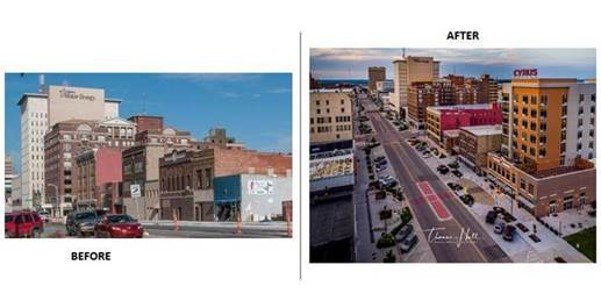How placemaking and policy innovation is revitalising city centres
The UK media is covered in headlines proclaiming the death of the high street. “High street woes,” they proclaim. “We’re facing the retail apocalypse.” While it’s true that footfall across UK highstreets is at a six-year low, this seems nihilistic. Instead, the high street is in a process of transformation. E-commerce has changed the face of retail, and that has had a clear knock-on effect on consumer shopping habits. Regardless though, we’re social animals and the desire for a communal public space remains strong – we just need to evolve our understanding of what our city centres are for.
City centres can offer an experience in a way that transcends digital offerings. Across the world, cities and towns are re-imagining their main streets, high streets and downtown districts by using innovative placemaking and policy reforms.
Transforming public spaces
American Main Streets and Downtown Districts are facing similar challenges to the British High Street. However, Downtowns have been a focus across America and Canada long before the UK began to address the decline of their own high streets. There are many examples of how creative place making has been used to reinvigorate community spirit and downtown economies.
Topeka, Kansas
A few years ago, Topeka found themselves in deep water. Like many smaller cities, Topeka faced a growing brain-drain as younger people left for bigger communities. And despite a large number of business based in Topeka, companies began to oversell the notion that you could live outside the city and commute in to work. “We were just outsourcing the potential taxing, income and resources to other communities, and beyond that, we were losing what made Topeka a great place to be,” explains Bob Ross, SVP Marketing & Communications for the Greater Topeka Partnership. “That’s when we began to look at Downtown.”
Over ten years, the Greater Topeka Partnership worked with private organisations to breathe life back into their Downtown. Businesses were asked to design pocket parks to represent themselves. Public art was commissioned to line the streets with diverse figures from the city’s history. A competition was launched to encourage entrepreneurs to propose a business downtown. And in March 2020, the Evergy Plaza will open with over 250 days of programmed events to build community spirit.

“In three years, we’ve gone from a downtown where you could have shot a canon down the middle and no one would have noticed, and we’re now having problems with parking, we now have blocks being built up around it,” Bob enthuses. “There’s this energy in Topeka right now, where people feel like they can make a difference… That’s the power of place making.”
Altrincham, Manchester
This is not to say the UK is falling behind on using place making to transform a city centre. In 2010, Altrincham was named a ghost town: with over 30% of its shops unused, it was England’s emptiest high street. Just eight years later though, Altrincham was crowned as the best high street in the country. Through a community-driven programme, the Altrincham BID team implemented a dramatic turnaround.
As the centre of the town, Altrincham Market was reinvented. When the council put the marketplace out for tender, they weighted the tender towards creativity over profitability. A small group of local people came forward and won the tender, making Altrincham Market House the heart of the community once again. Following that initial regeneration, restaurants and local businesses began to open up again in the vicinity.
As well as being selected to pilot the National High Street Perfect Day, Altrincham achieved record footfall in 2019, despite a national slump. And the 30% vacancy rate has been decreased to just under 10%. “There are still empty unity in the town. But we know what’s happening to them now,” admits Elizabeth Faulkner, BID Manager at Altrincham Unlimited, “They’re being refurbished… We’re becoming an experience high street.”
Policy that transforms your city
While Altrincham addressed their empty shops organically, there are many places who are using policy reforms to tackle the problem. Roeselare, a small city in Belgium, devised a multi-faceted strategy to address the decline in footfall. Alongside the construction of ARhus, Roeselare’s ‘knowledge centre’, the city implemented an empty shop tax. If a unit is empty for a month, a letter is sent to the landlord offering help in filling the space – but they’re also informed that if the property is still empty a year later, they’ll have to start paying tax.
“In the first year, they might pay between €5,000 and €10,000, but in the second year it doubles,” says Vanessa Dehullu, Head of Housing, Economics and Agriculture at Roeselare Council. “That’s a big motivation for them to drop rents if they’re starting to reach the end of the first year and they haven’t found an occupier.”
Roeselare also offers a number of other schemes, from allowing start-ups to rent units at a lower rate as a pop-up store, to offering funding to help businesses to open a second shop within the city. By incentivising businesses to stay in the centre of the city, Roeselare is able to preserve their vibrant sense of community.
The Airbnb of retail
There are even a few private-sector organisations which are stepping into this changing landscape of property rental. Appear Here – and US counterparts like Storefront – have positioned themselves as “the Airbnb of retail”, allowing retailers to rent stores for as short as a week.
Mark Bourgeois, managing director for the UK and Ireland at Hammerson – and one of Appear Here’s customers – says that the shorter-term leases helped to “maintain occupancy levels and deliver a great experience for our customers. We proactively use temporary leases to trial new concepts and to keep out destinations fresh for consumers.”
Despite concerns that the cheaper nature of temporary leases will destabilise rental values, it also opens up space for innovation and entrepreneurs to get a foothold in high streets, whilst infusing city centres with energy once more.
Impacts of the evolution of the city centre
City centres have become experience focussed. Through strategic place making initiatives public spaces are being improved and the community spirit is being bought back to the heart of cities and towns. Plus, with start-ups like Appear Here, there’s growing opportunity for businesses to take bold, creative risks.
Of course, with more people being drawn back to the renewed vibrancy of city centres, it’s possible that we’ll find ourselves facing the same neglect and disuse in our out-of-town shopping centres. “We’ve almost come a full circle… people said that the malls killed Downtown,” admits Bob Ross, “Now my next problem is what I do with the mall!”









